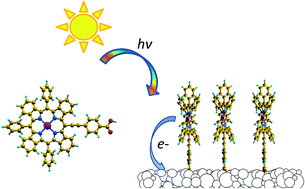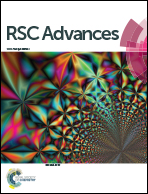Metal–organic green dye: chemical and physical insight into a modified Zn-benzoporphyrin for dye-sensitized solar cells†
Abstract
A new green unsymmetrical zinc triphenyl-tetrabenzoporphyrin compound, i.e. 5,10,15-(triphenyl),20-[ethynyl-(4-carboxy)phenyl]tetrabenzoporphyrinate Zn(II), has been synthesized as the first of a new class of dyes suitable for dye-sensitized solar cells. The molecule shows a hybrid porphyrin–phthalocyanine structure that allows a finer chemical and physical properties tuning with respect to phthalocyanines, by means of substitutions at the meso-positions, and a UV-vis spectrum that shows both an intense Soret band at 456 nm and a detectable Q band at 655 nm. The photophysical and redox properties of the molecule have been studied and show that HOMO and LUMO energy values are properly positioned for an effective charge transfer. DFT-based ab initio calculations have confirmed the energetic position of frontier orbitals and highlight the intricate structure of the visible spectrum and the charge transfer behavior of the molecule seen as a part of a complex device. Finally, dye-sensitized solar cells have been realized and IPCE and photovoltaic parameters have been measured, showing preliminary efficiency values of about 2%.


 Please wait while we load your content...
Please wait while we load your content...